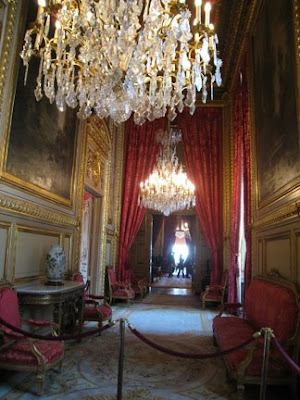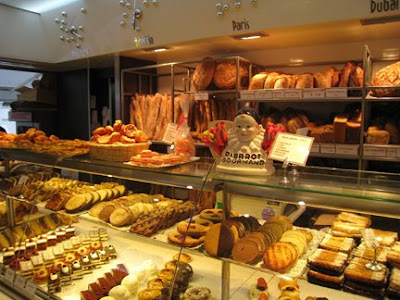We never intended to go inside Versailles as neither of us were interested in the gilded, baroque interiors or the mob scene to actually buy tickets and take the tour. We came for the gardens. I know, we're not really "garden" people either, but wanted to see the scale of this manicured paradise we'd heard so much about.

Again, not knowing much about the history of Versailles except that a lot of guys named Louis lived there, here are our top 10 weird & wonderful things about Versailles.
10. Rows of sculpted trees. The avenues are so long your eyes can't decipher it—the trees just about disappear into infinity. This seems to be the foundation of the garden with endless avenues and types of trees sculpted into perfection. It also showed man's (or the King's) dominance over nature.


9. Mowing. Even the guys at Versailles mow steep slopes by lowering a lawn mower down with a rope, just like our neighbor on Halpin. If they don't have a better way of doing it here, I guess there isn't one.

And I thought we had a lot of mowing obstacles in our yard...

8. Madame de Maintenon. Morganatic wife of King Louis XIV, she was the only member of royalty ever credited with saying "Hey, shouldn't we stop sinking money into this place and FEED our people?" I thought she deserved a mention for her opposition. Who knows, if the king had actually listened to his wife, the Revolution may have been averted. I think that's a lesson for us all...
7. Topiaries. These aren't fake, but are very dense, carefully manicured sculptures that show up everywhere throughout the gardens. Not a hair, or leaf in this case, out of place. Pat's favorites are the ones with "satellites."


6. The grand scale of it all. The gardens span about 3 miles from the the Chateau to the back of the Grand Canal and also about 1 1/2 miles on each side of it. At one time the Grand Canal had 9 ships, including a 32-cannon warship, in addition to Venetian gondolas for royal transportation over the waterway. It's huge. It's grand. You couldn't even really see front to back because there was a little haze in the air.


5. Garden transportation. Because of the grand scale, there are many modes of transportation rented to tourists to fully experience the gardens. These range from a tram, golf carts, bikes and Segways to row boats. We decided to stick with our feet (if we had known about Segway rental at the beginning that probably would have changed) and came to regret it later. It also begs the question how the royalty actually moved through the gardens. I can hardly see them trekking around in all that getup, powdered make-up dripping off their brows. It is said that Louis XIV had "15 rolling chairs upholstered in damask of various colors for his less energetic guests."

4. Man either emerging from, or returning to, the earth. The volcanic-like rock is a nice touch. If the fountains were on, it looks like water would shoot out of his mouth. Turns out, the real explanation is that this is the story of winter as "...a sad old Saturn lies down wearily amid the shells and seaweed." Looks more like agony than tiredness to me...

3. Marie Antoinette's Hamlet. Commissioned by Marie Antoinette, this was a collection of 8 small, idealized thatch-roofed cottages that may have inspired Disney himself. The plaster walls were even painted with cracks to make them look weathered and authentic. This life-size doll house came complete with vegetables, livestock, a mill, and dairy. Unlike any other part of the estate, access was strictly limited here and even the King had to ask her permission to come. Some describe this as a Queen's desperate attempt to get away from the grandeur and formality of the palace to a simpler, rustic country life. Others look at is as a perverse playground, costing too much money, and where even the lambs were groomed and perfumed for times when she wanted to play shepherdess.


Today sheep graze just outside of the Hamlet. With its extra-fluffy mane, this one looks like it could be worthy of Marie Antoinette's sensibilities.
2. The Orangerie. This is an entertaining symphony of plant placement. We think that every white tick mark on the ground will get a potted plant and, while we were there, workers were busy bringing them out of winter storage. This was just another way the King showed his power. Despite the fact that none of the 21 varieties of citrus, palm, pomegranate, clove, and oleander potted plants can survive in the French climate, HE was able to make them grow and bear fruit. This was (and is) an elaborately orchestrated and expensive proposition. Only outside in the warmer months, the pots are all carted back indoors inside massive cavities beneath the staircases and balustrade. In the 17th century, the gardeners kept the plants warm during the winter with fires made with coal imported from England. I'm guessing these plants were warmer than the peasants.



Careful... careful... this palm brushed the top of the giant doors, but certainly wasn't the tallest one we saw come out.

1. The Bosquet de la Salle de Bal. To us, this is the volcanic "Roman" amphitheater. Turns out this is more literally a "ballroom." According to some information I found, "...spectators were seated on... steps cushioned for them with a covering of grass. [I'm guessing the boxwoods weren't there then] Opposite them, water cascaded down the steps inset with shells brought back to France by Louis's navy from India, Madagascar and the Red Sea. The musicians stood above this cascade while dancers performed in the centre of the salle. Candelabra perched between the waterfalls illuminated this scéne de fée."




Some unfortunate worker had the pleasure of individually wiring each of these stones to a framework judging by a small hole we found.
If you end up in the neighborhood, it's good to know that the gardens themselves are free, but just about anything inside will cost. On summer weekends, starting in April, they turn on all the fountains and play music. They also charge an admission. As Pat said, that's probably fair since there are SO MANY fountains that they probably need the money to break even on the utility bills :) Seeing the gardens with the fountains on would totally change it and, I'm sure, would be even more impressive. I guess it gives us a reason to possibly return someday.
Built for Kings given power by God himself, this place is insane. As you walk around, you can't help but quote Mel Brooks... "It's good to be the King."





































